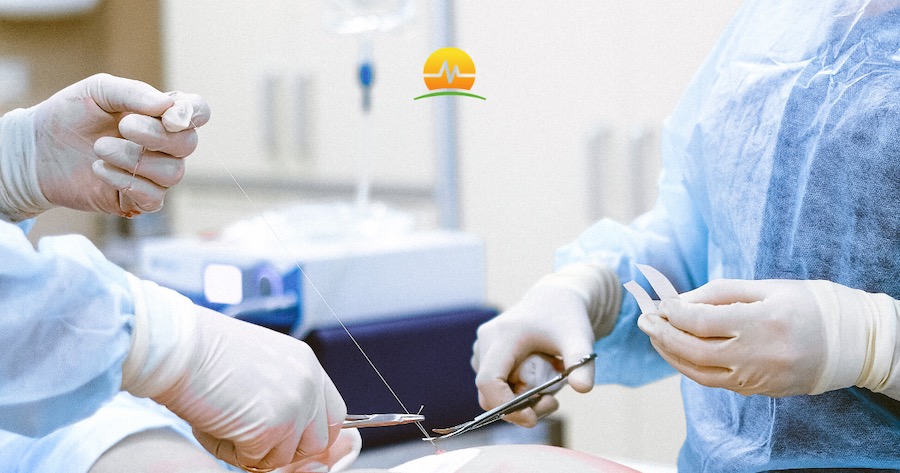Incisional Hernia Surgery
Incisional hernias are defects in the fascia of the abdomen that occur as a result of a surgical procedure where the abdominal musculature and fascia is breached. They represent about 15-20% of all abdominal hernias.

Incidence of Incisional Hernias
Incisional hernias were far more common when open surgery was the standard of care for all surgical procedures. Due to the single long incision necessary during open surgery, the risk of a hernia after the procedure was significant. By some estimates, the risk of a hernia is 15% or more. However, with the advent of minimally invasive or laparoscopic surgery, the large single incision was replaced with 4 to 5 small incisions. Each of these incisions is about 5 to 8 mm. Some procedures require an incision up to 12 or even 15 mm. However, these are still relatively small when compared to open surgery. As a result, the incidence of an incisional hernia after laparoscopic procedure is very low – around 1 to 2%.
Diagnosis of Incisional Hernias
Incisional hernias are relatively easy to diagnose. Typically, you will see or feel a lump in the abdomen over or near a previous incision site when you stand or exert yourself. When you lie down, the hernia will typically reduce back into the abdomen and disappear. The lump may be accompanied by pressure or pain at the site of the hernia.
Why Repair an Incisional Hernia?
While incisional hernias do not incarcerate or strangulate as often as inguinal or femoral hernias, there is still a risk that the contents of the hernia – typically a loop of intestine or fat – can get strangulated and cause a life-threatening situation requiring emergency surgery. That said, incisional hernias often grow in size relatively quickly and therefore should be evaluated by a qualified general surgeon as early as possible. For some, watchful waiting may be sufficient, while for others, early surgery will be indicated. Typically, the smaller the incisional hernia, the easier it is to repair, with fewer complications.
Surgery to Correct an Incisional Hernia
Currently, the standard of care for repairing an incisional hernia is laparoscopy and mesh. The mesh creates a non-tension repair of the hernia and allows natural scar tissue to bind with the mesh to create a very strong lattice and significantly reduce the risk of recurrence or reappearance of the hernia. Traditional tension repair using sutures to close the defect have a much higher incidence of recurrence. Recurrence rates are higher in patients with type-two diabetes and those that smoke.
The majority of our incisional hernia repairs are performed using robotic surgical techniques. 99% of patients are discharged on the same day of surgery. The minimally invasive nature of the procedure means that there is relatively little pain and most patients will not require narcotic medication.
Recovery from Surgery
During the immediate recovery, you will be asked to stand up and walk around the surgery center to get blood flowing and improve healing, while reducing the likelihood of infection. You will require someone to drive you home after the procedure and you will likely need someone to help around the house for the first several days after surgery. Please feel free to have this person ask questions before discharge. You may not retain all of the instructions given while you are still recovering from anesthesia.
Once home, recovery after an incisional hernia is similar to that of other hernias. You will have a follow up appointment about 10 days to two weeks after surgery to check the incision and make sure that recovery is progressing appropriately. Most patients can return to work within a few days of surgery. Strenuous activity and lifting should be avoided for at least six weeks after surgery or when your surgeon gives the OK.
The full recovery protocol after incisional hernia will be detailed in the postoperative packet.
Wound care for an incisional hernia is much the same as any surgical procedure. Your postoperative packet will give you specific instructions. If a dressing needs to be handled, it should be replaced with a clean, sterile one. No ointments or creams should be used on the wound unless specifically told by your surgeon. Hands should always be washed thoroughly with soap and warm water when handling the wound.
Long-Term Prognosis
The prognosis for an incisional hernia is excellent. Repairs are extremely successful and last for a long time. Most patients will never experience a recurrence of the hernia; however, signs of recurrence should be brought to your surgeon’s attention if they do manifest. Women who become pregnant after an incisional hernia should speak to their surgeon and OB/GYN to minimize potential complications.
We encourage you to ask questions during your consultation. Of course, we are always there for you after surgery as well. In the meantime, please contact our office to learn more about scheduling a consultation with one of our surgeons.
Related Hernia Resources
- Inguinal (Groin) Hernias
- Femoral (Thigh) Hernias
- Umbilical (Bellybutton) Hernias
- Ventral Hernias
- Hernia Surgery
- Hernia Overview
